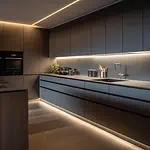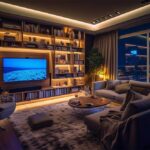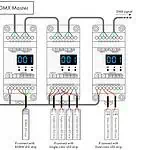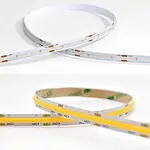The EU commission has proposed new ErP and energy label directives for LED products in a bid to increase energy efficiency and reduce CO2 emissions.
What is ErP?
ErP is the abbreviation of Energy-related Products. It also refers to Energy-related Products Directive (ErP) 2009/125/EC that replaced the old Energy-using Products Directive (EuP) in November 2009. The original EuP was taken into use in 2005 to fulfill the Kioto agreement requirements for reducing carbon dioxide emissions.
The ErP broadened the range of products that were covered in EuP. Earlier only directly energy-consuming (or using) products were covered. Now ErP directive also covers the products related to energy. This could be for example water-saving taps, etc.
The idea is to cover the whole product supply chain: design stage, production, transport, packaging, storage, etc.
The former ErP directives EC 244/2009, EC 245/2009, EU 1194/2012 and Energy Label directive EU 874/2012 had been taken effect for more than10 years. Recently, the European Commission has reviewed these regulations and analyzed the technical, environmental and economic aspects of lighting products as well as real-life user behavior and issued new ErP directives EU 2019/2020 and energy label directive EU 2019/2015.
New ErP & Energy Label Directives Timeline
New ErP Directive (EU) 2019/2020
- Effective date of the regulation: 2019.12.25
- Regulation implementation time: 2021.09.01
- Old regulations and their expiry time: (EC) 244/2009, (EC) 245/2009 & (EU) 1194/2012 will be invalid from 2021.09.01
New Energy Efficiency Labeling Regulation (EU) 2019/2015
- Effective date of the regulation: 2019.12.25
- Regulation implementation time: 2021.09.01
- The old regulations and their expiry time: (EU) No 874/2012 will be invalid from 2021.09.01, the energy efficiency label of lamps will be invalid from 2019.12.25
New ErP Directive Scope
This Regulation establishes ecodesign requirements for the placing on the market of
(a) light sources;
(b) separate control gears.
The requirements also apply to light sources and separate control gears placed on the market in a containing product.
Light Sources Definition
‘light source’ means an electrically operated product intended to emit, or, in the case of a non-incandescent light source, intended to be possibly tuned to emit, light, or both, with all of the following optical characteristics:
(a) chromaticity coordinates x and y in the range
(Note: only white light in this range, red/green/blue/yellow/pink colors light are not)
0,270 < x < 0,530 and 2,3172 x2 + 2,3653 x – 0,2199 < y < – 2,3172 x2 + 2,3653 x – 0,1595;
(b) a luminous flux < 500 lumen per mm2 of projected light-emitting surface area as defined in Annex I;
(c) a luminous flux between 60 and 82 000 lumen;
(d) a colour rendering index (CRI) > 0;
using incandescence, fluorescence, high-intensity discharge, inorganic light emitting diodes (LED) or organic light emitting diodes (OLED), or their combinations as lighting technology, and that can be verified as a light source according to the procedure of Annex IV.
High-pressure sodium (HPS) light sources that do not fulfil condition (a) are considered light sources for the purposes of this Regulation.
Light sources do not include:
(a) LED dies or LED chips;
(b) LED packages;
(c) products containing light source(s) from which these light source(s) can be removed for verification;
(d) light-emitting parts contained in a light source from which these parts cannot be removed for verification as a light source;
Control Gear Definition
‘control gear’ means one or more devices, that may or may not be physically integrated in a light source, intended to prepare the mains for the electric format required by one or more specific light sources within boundary conditions set by electric safety and electromagnetic compatibility. It may include transforming the supply and starting voltage, limiting operational and preheating current, preventing cold starting, correcting the power factor and/or reducing radio interference.
The term ‘control gear’ does not include power supplies within the scope of Commission Regulation (EC) No 278/2009 (14). The term also does not include lighting control parts and non-lighting parts (as defined in Annex I), although such parts may be physically integrated with a control gear or marketed together as a single product.
A Power over Ethernet (PoE) switch is not a control gear in the sense of this Regulation. ‘Power-over-Ethernet switch’ or ‘PoE switch’ means equipment for power-supply and data-handling that is installed between the mains and office equipment and/or light sources for the purpose of data transfer and power supply;
Separate Control Gear Definition
‘separate control gear’, means a control gear that is not physically integrated with a light source and is placed on the market as a separate product or as a part of a containing product;
Containing Product Definition
‘containing product’ means a product containing one or more light sources, or separate control gears, or both. Examples of containing products are luminaires that can be taken apart to allow separate verification of the contained light source(s), household appliances containing light source(s), furniture (shelves, mirrors, display cabinets) containing light source(s). If a containing product cannot be taken apart for verification of the light source and separate control gear, the entire containing product is to be considered a light source;
New ErP directive requirements
Energy efficiency requirements
(a) From 1 September 2021, the declared power consumption of a light source Pon shall not exceed the maximum allowed power Ponmax (in W), defined as a function of the declared useful luminous flux Φuse (in lm) and the declared colour rendering index CRI (-) as follows:
Ponmax = C × (L + Φuse/(F × η)) × R;
where:
- The values for threshold efficacy (η in lm/W) and end loss factor (L in W) are specified in Table 1, depending on the light source type. They are constants used for computations and do not reflect true parameters of light sources. The threshold efficacy is not the minimum required efficacy; the latter can be computed by dividing the useful luminous flux by the computed maximum allowed power.
- Basic values for correction factor (C) depending on light source type, and additions to C for special light source features are specified in Table 2.
- Efficacy factor (F) is:
1,00 for non-directional light sources (NDLS, using total flux)
(Note: You can check the IES report to confirm whether it is a non-directional light, all our LED strip are non-directional lights)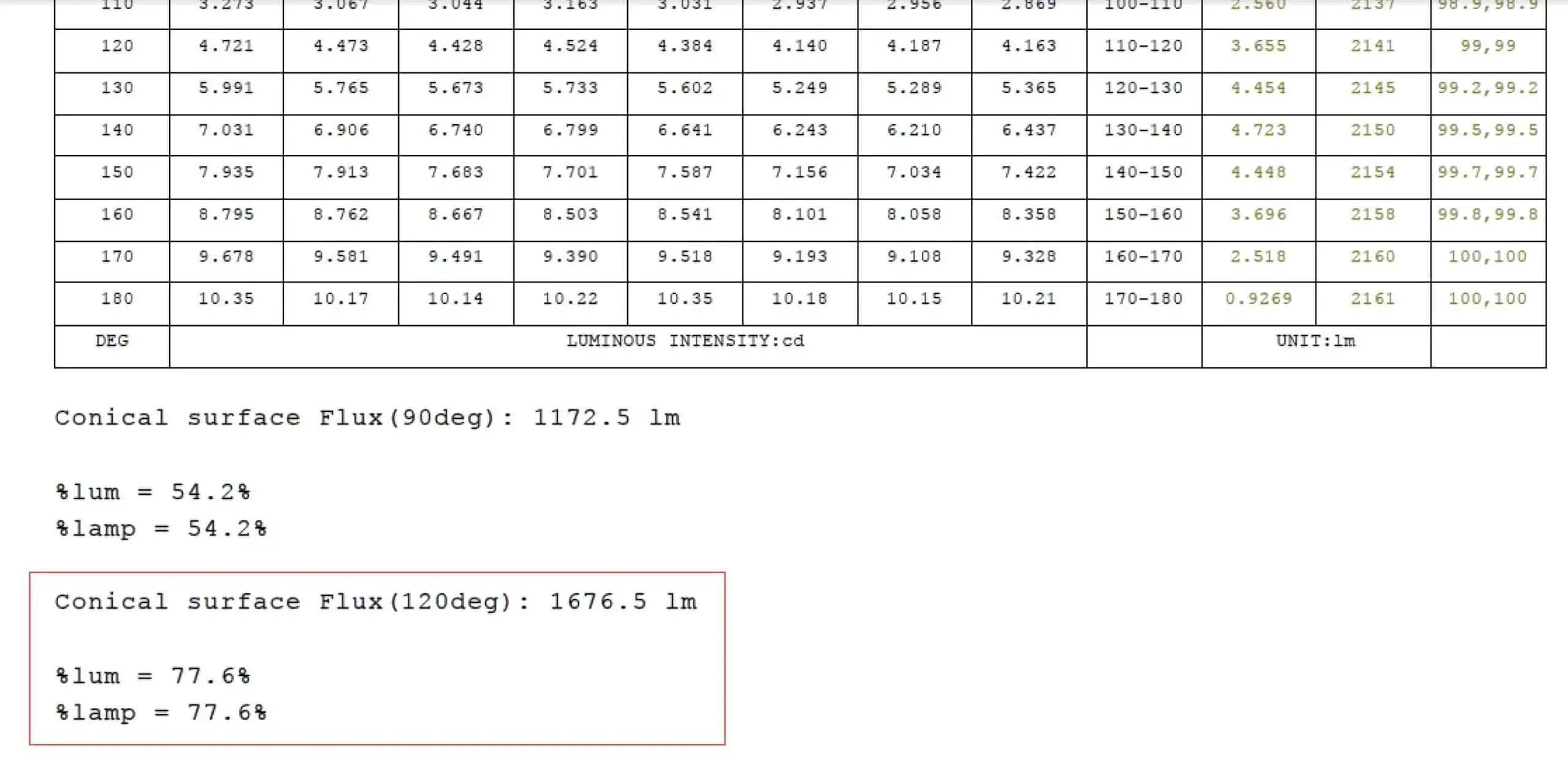
0,85 for directional light sources (DLS, using flux in a cone) - CRI factor (R) is:
0,65 for CRI ≤ 25;
(CRI+80)/160 for CRI > 25, rounded to two decimals.
Table 1
Threshold efficacy (η) and end loss factor (L)
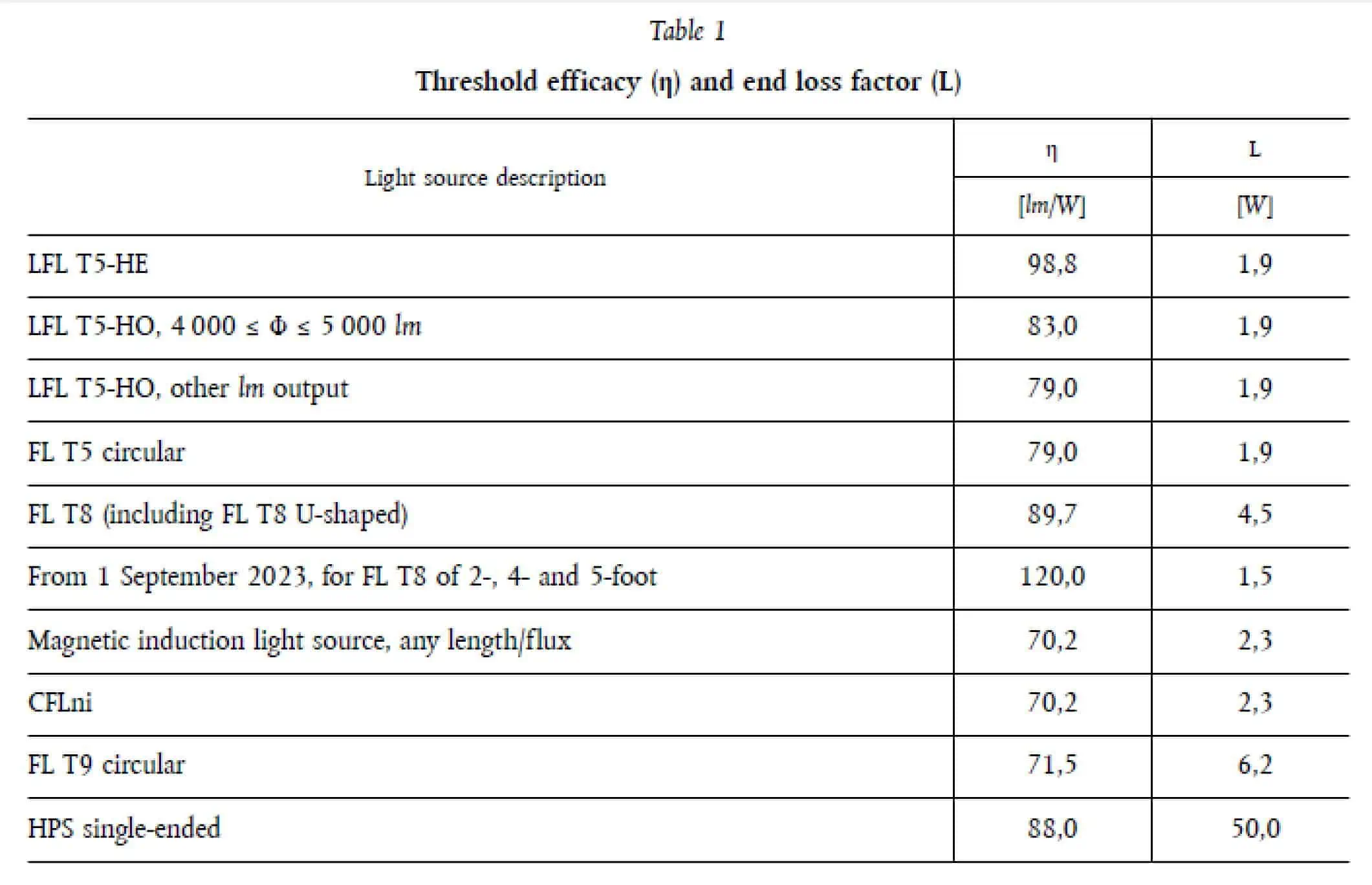
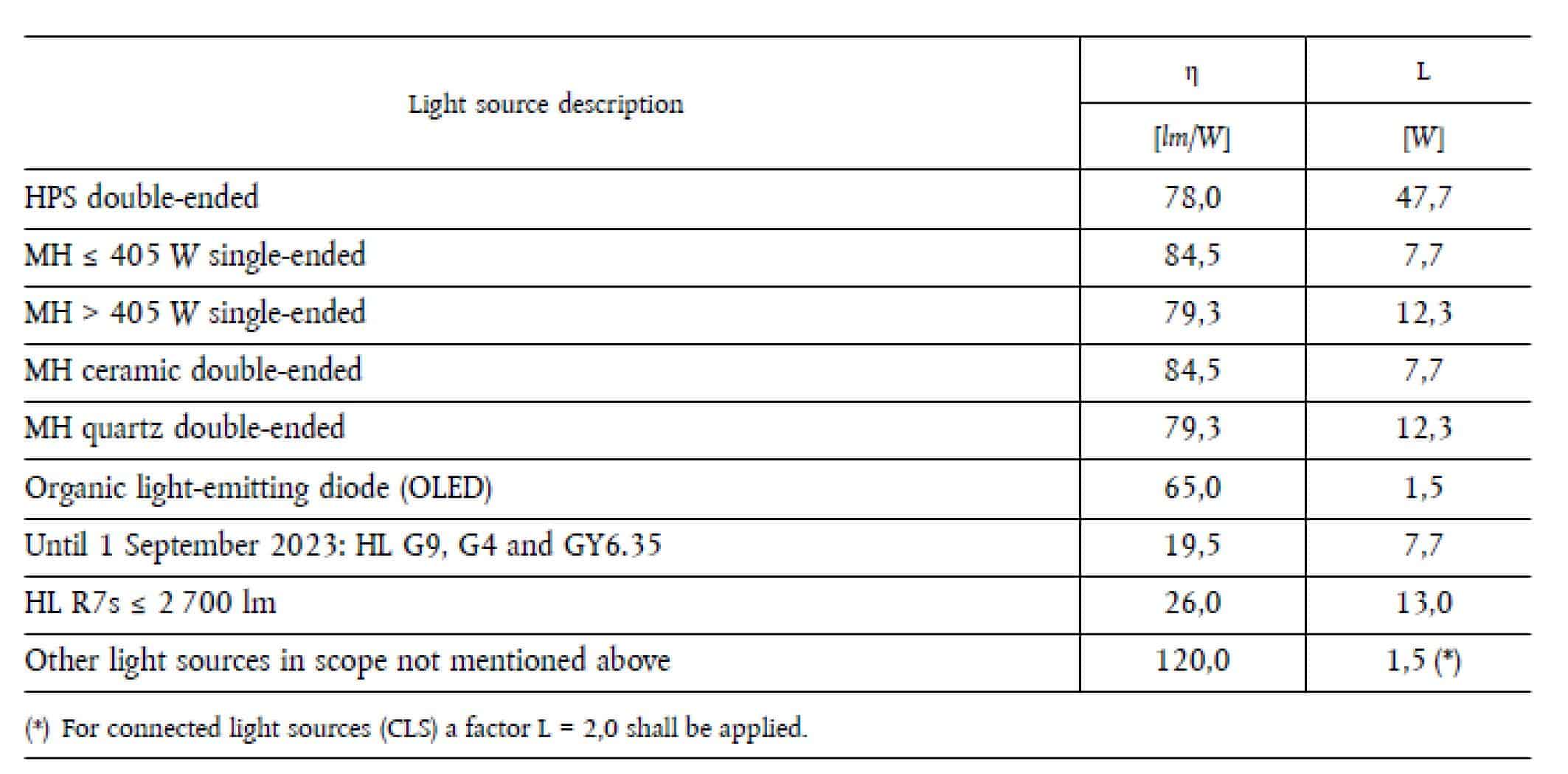
Table 2
Correction factor C depending on light source characteristics
Where applicable, bonuses on correction factor C are cumulative.
The bonus for HLLS shall not be combined with the basic C-value for DLS (basic C-value for NDLS shall be used for HLLS).
Light sources that allow the end-user to adapt the spectrum and/or the beam angle of the emitted light, thus changing the values for useful luminous flux, colour rendering index (CRI) and/or correlated colour temperature (CCT), and/or changing the directional/non-directional status of the light source, shall be evaluated using the reference control settings.
The standby power Psb of a light source shall not exceed 0,5 W.
The networked standby power Pnet of a connected light source shall not exceed 0,5 W.
The allowable values for Psb and Pnet shall not be added together.
(b) From 1 September 2021, the values set in Table 3 for the minimum energy efficiency requirements of a separate control gear operating at full-load shall apply:
Table 3
Minimum energy efficiency for separate control gear at full-load
Multi-wattage separate control gears shall comply with the requirements in Table 3 according to the maximum declared power on which they can operate.
The no-load power Pno of a separate control gear shall not exceed 0,5 W. This applies only to separate control gear for which the manufacturer or importer has declared in the technical documentation that it has been designed for no-load mode.
The standby power Psb of a separate control gear shall not exceed 0,5 W.
The networked standby power Pnet of a connected separate control gear shall not exceed 0,5 W. The allowable values for Psb and Pnet shall not be added together.
Functional requirements
From 1 September 2021, the functional requirements specified in Table 4 shall apply for light sources:
Table 4
Functional requirements for light sources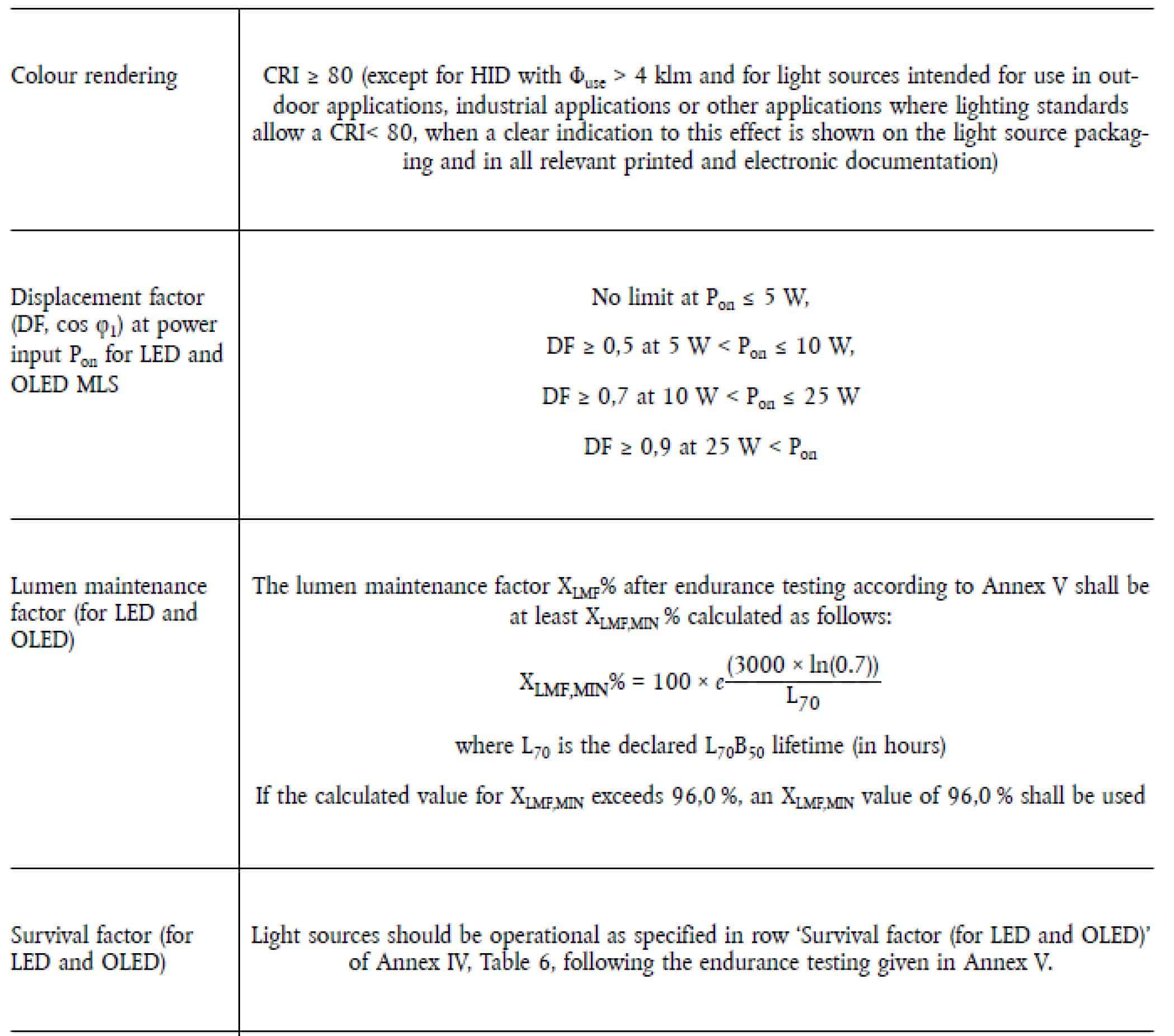
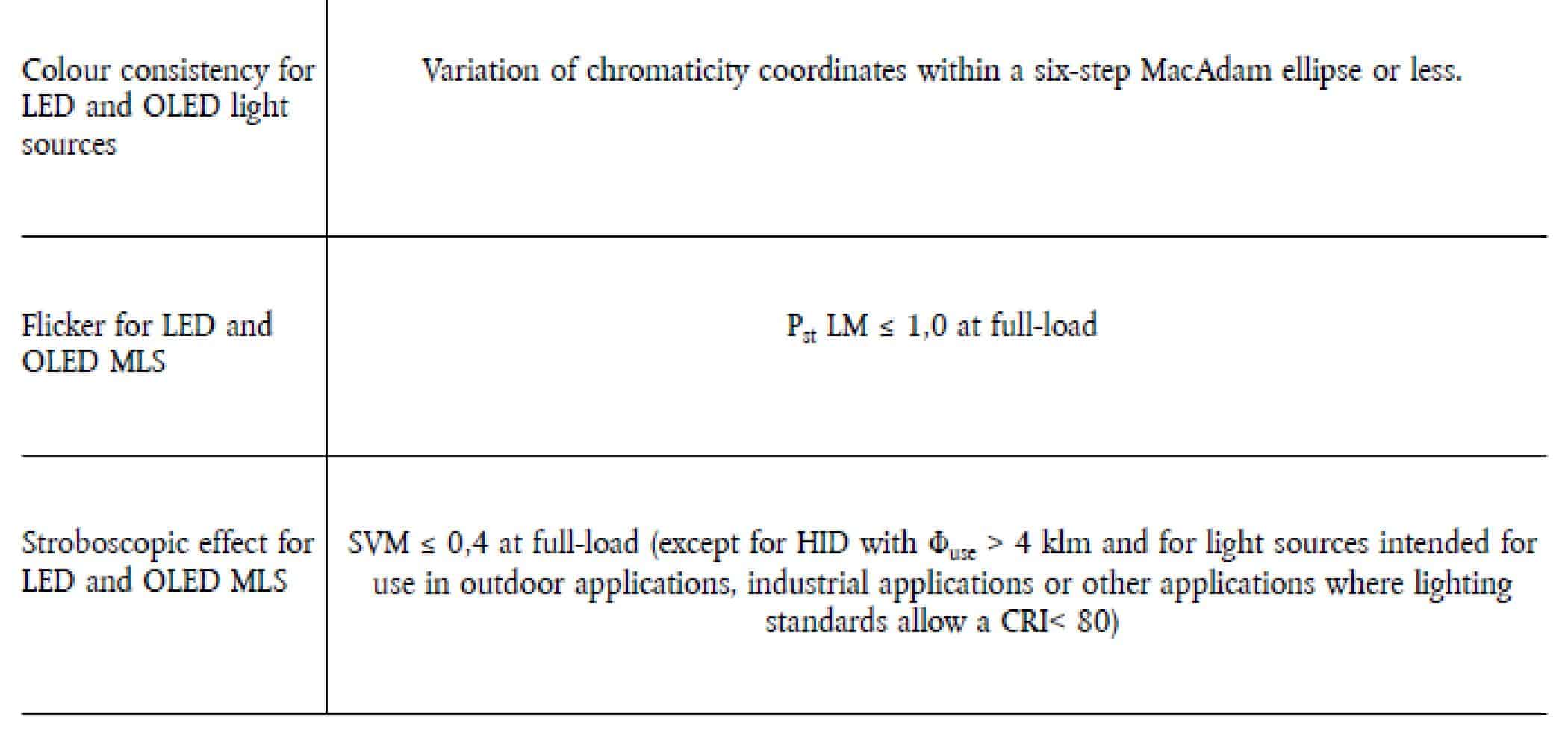
Information requirements
From 1 September 2021 the following information requirements shall apply:
(a) Information to be displayed on the light source itself
(b) Information to be visibly displayed on the packaging
(c) Information to be visibly displayed on a free-access website of the manufacturer, importer or authorised representative
(d) Technical documentation
Energy efficiency classes and calculation method
Energy efficiency label rating calculation formula
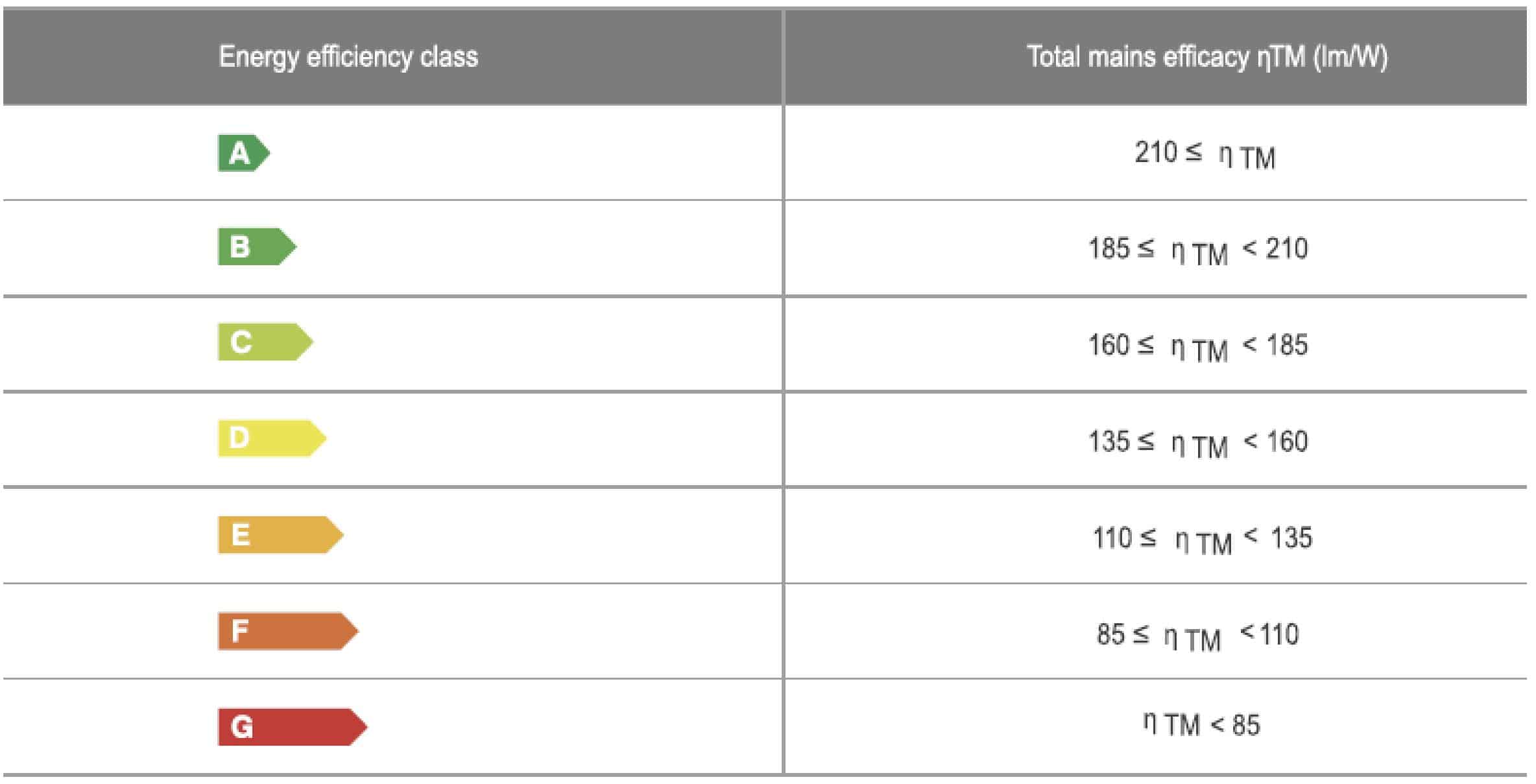
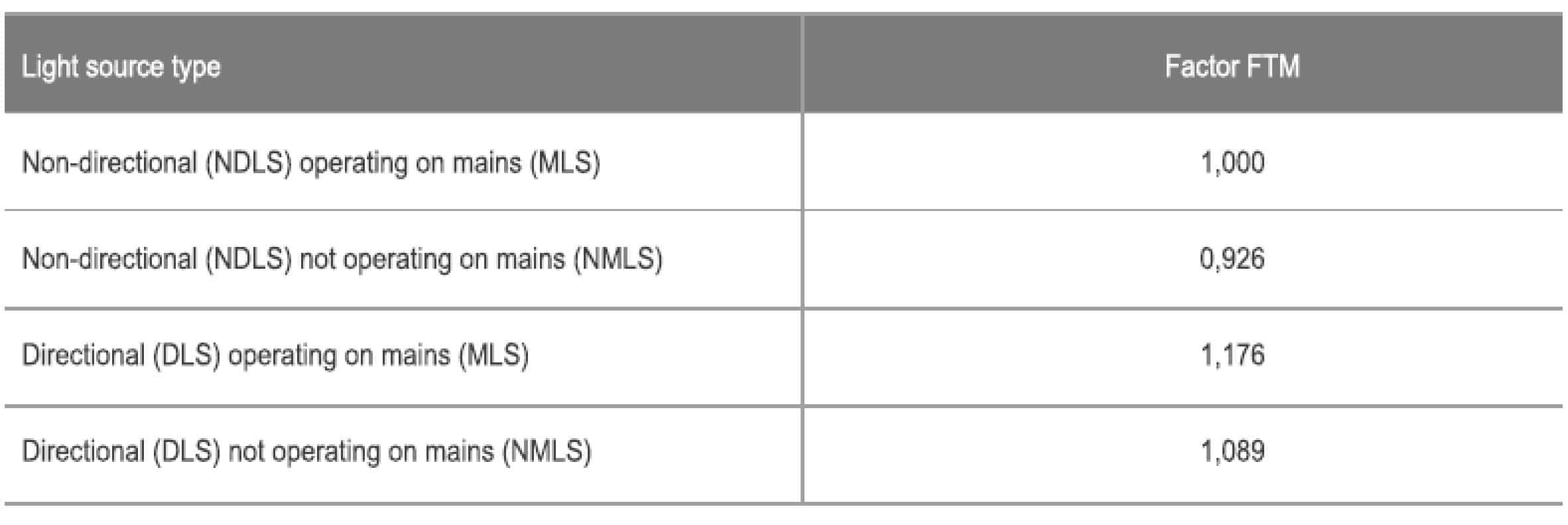
Note: Sample requirements for LED strip light sources:
- Take 50cm as the model length, and specify or provide a control device suitable for this length
- 10 pcs
For ErP label registration website, please click here, but only EU companies can register.
Useful reference documents
Official Journal of the European Union
LEDYi manufactures high-quality LED strips and LED neon flex. All of our products go through high-tech laboratories to ensure the utmost quality. Besides, we offer customizable options on our LED strips and neon flex. So, for premium LED strip and LED neon flex, contact LEDYi ASAP!
